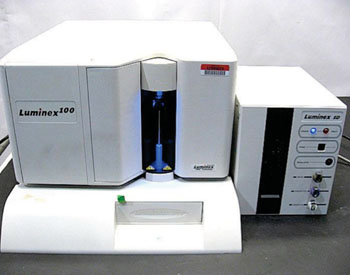Noninvasive Test Identifies Childhood Metabolic Disease Risk
By LabMedica International staff writers
Posted on 25 Jun 2014
Salivary biomarkers have been used as a tool for identifying children who are at risk for developing Type 2 diabetes (T2D).Posted on 25 Jun 2014
The study of obesity-related metabolic syndrome or T2D in children is particularly difficult because of fear of needles; however a noninvasive approach to study inflammatory parameters in an at-risk population of children may provide proof-of-principle for future investigations of vulnerable subjects.

Image: The Luminex 100 multiplex analyzer (Photo courtesy of Luminex Corporation).
Scientists from the Forsyth Research Institute, Cambridge, MA, USA) working with colleague in Kuwait, evaluated metabolic differences in 744, 11-year old children selected from underweight, normal healthy weight, overweight and obese categories by analyzing fasting saliva samples for 20 biomarkers. Saliva supernatants were obtained following centrifugation and used for analyses.
All assays on the 744 saliva samples for the 20 biomarkers were performed on saliva supernatant using four multiplex magnetic bead panels on a Luminex 100 platform (Luminex, Austin, TX, USA). A subset of 213 saliva supernatants (approximately 54 from each body weight category) were randomly selected and assayed for total protein. The assay was performed using the commercial kit Pierce 660 nm protein assay, (Pierce Biotechnology Rockford, IL, USA) which has a working range of 50 to 2,000 µg/ml. Protein values were determined on saliva supernatant samples using bovine serum albumin as a standard implemented on a robotic chemical analysis unit, the EVO 100 with a Sunrise spectrophotometer set at 660 nm, (Tecan US; Morrisville NC, USA).
Salivary C-reactive protein (CRP) was six times higher, salivary insulin and leptin were three times higher, and adiponectin was 30% lower in obese children compared to healthy normal weight children. Categorical analysis suggested that there might be three types of obesity in children. Distinctly inflammatory characteristics appeared in 76% of obese children while in 13%, salivary insulin was high but not associated with inflammatory mediators. The remaining 11% of obese children had high insulin and reduced adiponectin. In the non-obese children 40% were found in groups which, based on biomarker characteristics, may be at risk for becoming obese.
The authors concluded that they had identified four salivary biomarkers in their study subjects that change significantly with increasing obesity; insulin, CRP, adiponectin, and leptin. The results of this study suggest that obesity may be characterized and classified by salivary biomarker concentrations. The use of these relatively noninvasive markers, particularly in longitudinal studies, to investigate the development of metabolic diseases in children and to evaluate therapeutic interventions, could be used to develop prevention strategies. The study was published on June 10, 2014, in the journal Public Library of Science ONE.
Related Links:
Forsyth Research Institute
Luminex
Pierce Biotechnology












.jpg)
